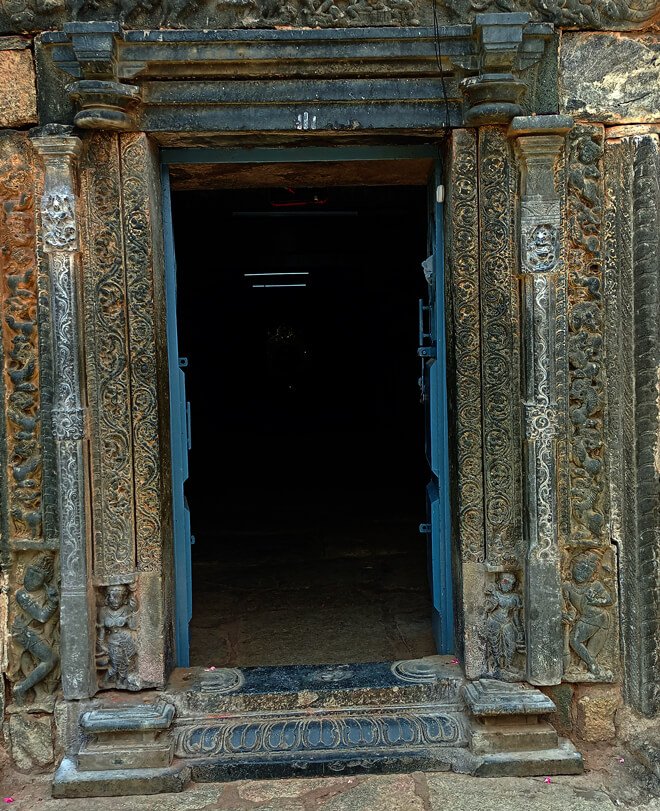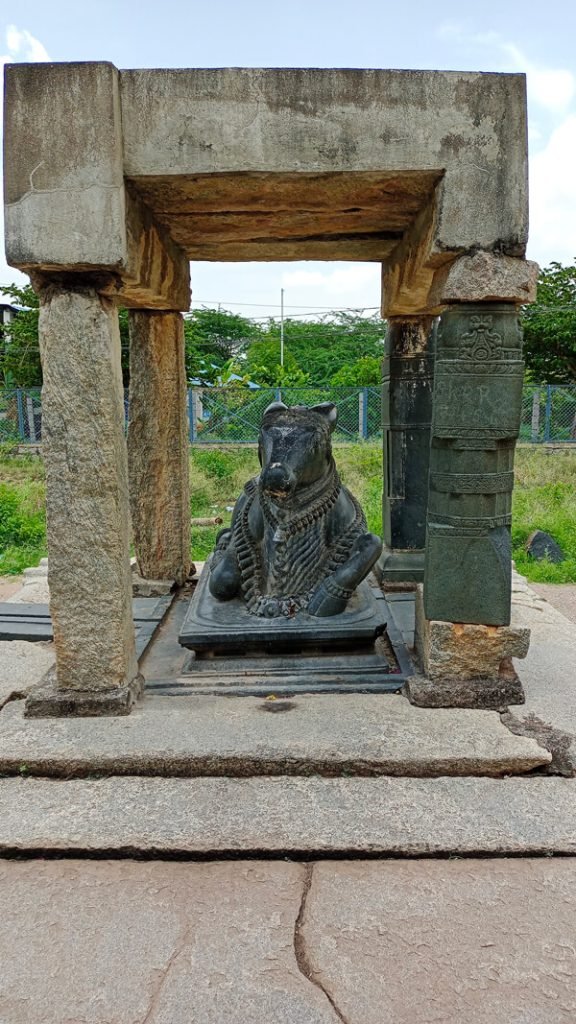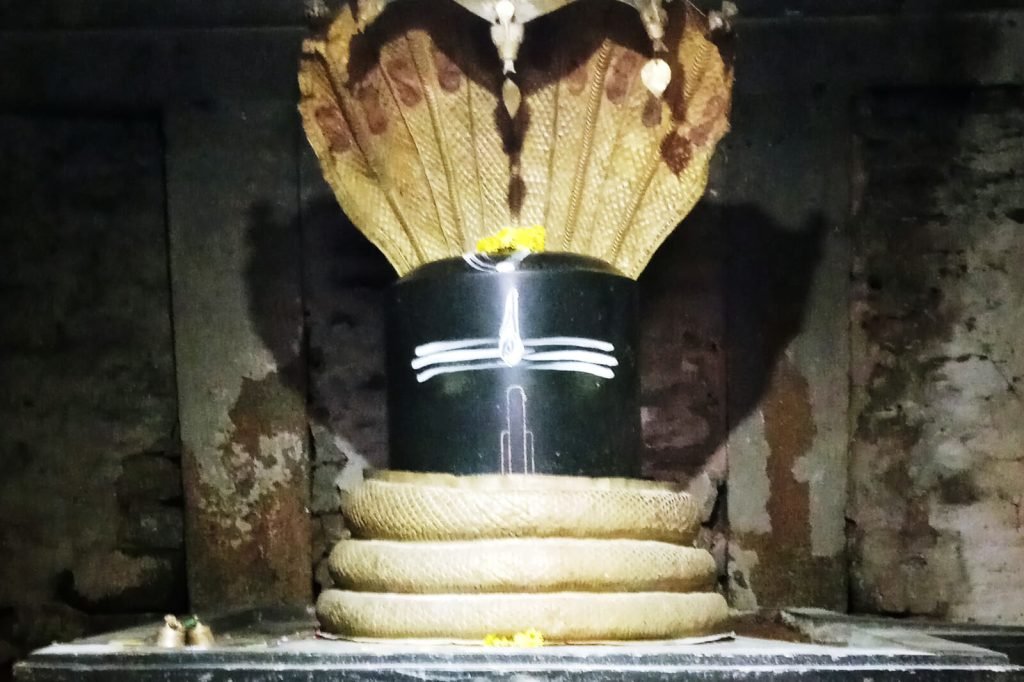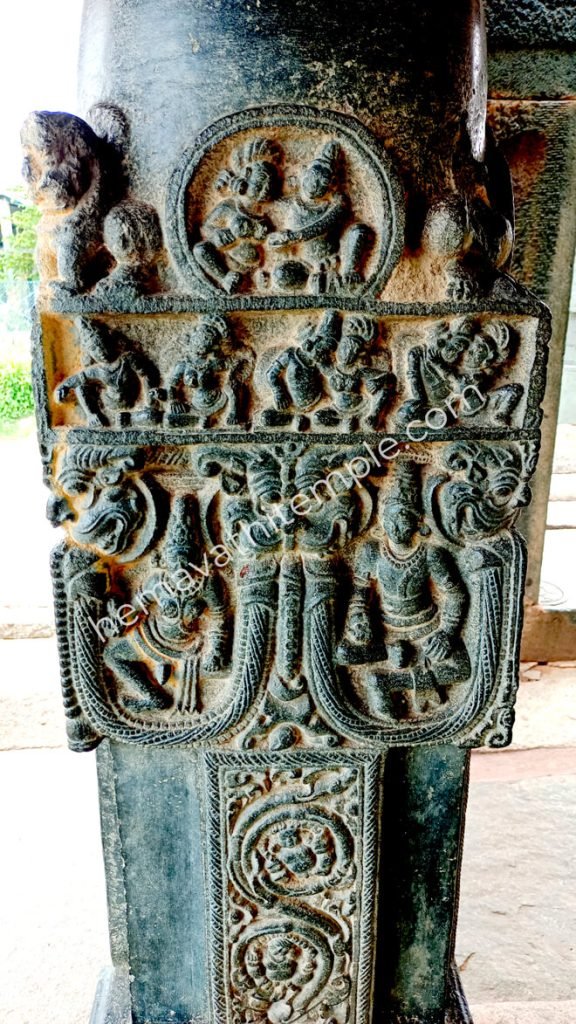sri sri sri
Malleswara Swamy Temple
The Malleswara temple in Hemavati with its eastern entrance is now only half standing. The linga of Malleswara Swamy is bright with the rays of the morning sun. It is situated on the left side of the Doddeswara Swamy temple in an outdoor area which is scenic and natural. The front gates of the temple have fallen and some of them have been preserved in the museum. Temple’s (front entrance can be seen in the map) “It is no exaggeration to say that nothing in Hemavati is as majestic and smooth as the Nandi in the mandap opposite the Shivalinga.
It is believed that Nandi’s two ears were broken off by miscreants and the precious diamonds encrusted in them were stolen. Although the walls of this temple are currently in ruins, the craftsmanship in the stone pillars is amazing. Bhagavata stories are very beautiful in this. In this one of the pillars, Goddess Lakshmi can be seen very well appearing in the context of the goddess Lakshmi pouring nectar with mandara giri. If you look closely at all the walls, pillars and ceilings, it can be said that Hemavati is the measure of Yavadbharata stories.
In the pillars of this temple, the carvings of Srimannarayana Dashavathara, Natyamayuri, Bairavarupa Shiva riding on Nandi Vahana, and Mahishasura Vardini, which are rare in the world, are prominently seen. Also, black stone is used on one side of the stairs in the stairway going down from the temple.
In it, Shiva Parvati is seen riding on the chariot of Sarabha, an animal bigger than a lion, and Sarabha is advancing from an elephant that has fallen.
In this scene, even small children will know that lions and lions are more powerful animals than lions.





Distillation of milky ocean
During the reign of Manu, the celestial deities engaged in the churning of the milky ocean, an important event known as churning of the milky ocean, described in the Bhagavata, the Balakanda of the Ramayana, the Adi Parvam of the Mahabharata, and various Puranas.
When the gods and demons began the monumental task of churning the milky ocean, the weight of Mandaragiri, initially lifted, became too much, prompting Vishnu in his Garudarudha form to intervene. He skillfully placed Mandaragiri in the ocean of milk and, seeking the cooperation of Vasu, turned the serpent into a churning cord. Vishnu, now atop Mandaragiri, begins the churning process, pleading with Vasuki to play a vital role in producing the coveted nectar. However, as the Rakshasas angrily positioned themselves at Vasuki’s tail, tensions rose among the participants, questioning the integrity of the deities. In response to this conflict, Lord Vishnu assumed the form of Kurma and lifted Mandaragiri and placed it securely on his back. The churning began with a deafening roar, leading to an unfortunate loss of life among the various creatures of the turbulent Aroda.
Amidst the cosmic tumult caused by the churning of the milky ocean, the gods, foreseeing the potential chaos, turned to Tochaka Brahma for guidance. Seeking a solution, Brahma approached Vishnu, who sought Shiva’s intervention in the peaceful abode of Kailasa. In response to the plea, Lord Shiva willingly accepted the consequences of churning and took the potent substance down his throat, transforming into Garalkantha. However, this action released intense heat and fever, forcing Shiva to pursue remedies. To counter those effects, he adorned the moon born from the churning of the ocean of milk on his head and placed Gangammathalli on his scalp. Despite these measures, challenges to Lord Shiva continued, leading devotees to perform regular Udaka Abhisheka to the sacred Shivalinga to alleviate eternal troubles.
Following the initial churning of the milky ocean, the divine effort continued, giving rise to many celestial bodies. In creation there are Kamadhena, Ucchaisrava, Airavata, Kalpavriksha, bewitching Apsaras, radiant Moon and auspicious Mahalakshmi. Indra claimed Kamadhena, the Kalpa tree and Airavata, while the majestic Ucchaisrava found his place of worship as an offering to Emperor Bali. This celestial ensemble represents the incarnation of Goddess Lakshmi, gracing the Milky Way with her divine presence during the sacred event known as Lakshmi Kalyanam.
Lord Brahma licked the body of Goddess Lakshmi with the water of Palasamudra.
Immediately after the birth of Mahalakshmi, she is given a holy bath.
Samudru gives her silk clothes. Varuna gives the garland of victory. Vishwakarma gives gold ornaments. Gazing at her, Vishnu went to Lakshmi Devi (Sridevi) and said to the deities: “There is no happiness if you join anyone else. If Vishnu is Lord, I will be eternally happy. “And put a garland of flowers around Vishnu’s neck. Then Samudra took Kaustubhamani and gave it to Vishnu. Vishnu placed Mahalakshmi along with Kaustubhamani on his bosom.

The gods started churning again. Then Varuni (Sura or Kallu) was born. The demons ask Varuni and give it to the Danavas. During the churning of the milky ocean, many unpleasant things emerge. All were shared by the chiefs of the gods. But the demons were offered Surabandha, to drink Surabandha (Kabolu) freely to wash away the labor of churning the ocean.
Anargha Ratnams born during Palapitta
Kallu Peethadhipati Surabandham
Apsaras – Rambha, Menaka, Ghritachi, Tilottama, Sukeshi, Chitralekha, Manjughosha
Kaustubham, precious ruby
Uchchaisrava, the seven-headed god
Kalpa tree, wish-fulfilling tree
Kamadhenu, the cow that drives desires, is the mother of all cow offspring
Airavata, the elephant which is the vehicle of Indra
Goddess Lakshmi, Goddess of Wealth
The Parijata tree is a tree that bears flowers that never wither
Halahala, Kalakoota poison
Moon, the god of coolness, is the ruler of the mind
Dhanvantari, Vaidyashikhamani of the gods
Elixir, which makes deathless.

Birth of Dhanvantari with Amrita Kalash – Mohini Avatar of Mahavishnu
Then Dhanwantari appears with a pot of amrita. Seeing Amrita, the demons fell on each other and started beating each other. Elixir is changing hands in the battle of demons. The gods bowed down and prayed to Vishnu. Vishnu comforts them and takes the avatar of Jaganmohi and comes to those demons. Lord Vishnu, who is the embodiment of Jaganmohini, moves here and there, shedding light on the Vairas, and the demons chase Jaganmohini and tell the story of what happened till then, and the gods and demons will become brothers and sisters, that amrit. obtained from churning the sea, and they ask that the nectar be distributed to both of them. Then Jaganmohini divided the deities and the demons into two lines, placed amrita kalas on the darbha, poured amrita to the deities and seduced the demons with her vyayaram. The demon Rahu realized this and sat in the row of deities. The Sun and the Moon communicated this through a sign to Maha Vishnu (Jaganmohini) and Vishnu cut off his head with the Sudarshana Chakra. The demons next door did not know that. The nectar is gone. Jaganmohini disappeared.
Solar and lunar eclipses
But Rahu did not die because he had already taken the nectar. The head and torso were separated and the head was called Rahu and the torso Ketu. Every year, Rahu and Ketu try to swallow the Sun and the Moon with the intention of harming the Sun and the Moon. This is called solar eclipse and lunar eclipse.
Snakes have two tongues
Seeing all that happened, Vasuki turned pale. When Ksirasagara was milking the milk, he did not get the amrita he was supposed to give as he was unable to get the amrita, so he went to the place where the amrita pot was placed and touched the darbhas. He wonders if any nectar has fallen on them. No nectar was obtained, but Darbha’s sharp tongue went to the saree. Since then the serpents belonging to the Vasu family look like two tongues with their tongues extended vertically.
In Hemavati
Famous Shiva Temples
Siddeshwara Swamy Temple
During Chaitram and Vaisakh months, it is wonderful to see the sunlight touching the 5.8 feet tall Siddeshwara Swamy during the dusk.
Doddeswara Swamy Temple
Sri Doddeswara Swamy Temple has Saiva Purana stories as well as Vishnava Purana stories engraved in them. Opposite the largest Nandi temple.
Chela Bhairava Swamy Temple
It is believed that if jaggery is offered in the temple of Sri Chelabhairavaswamy, the Swami will protect their house from snakes, scorpions and any other poisonous insects.
Malleswara Swamy Temple
In the Malleswara Swamy temple, the lingam shines brightly with the rays of the morning sun. It is on the left side of Doddeswara temple.
Virupaksheswara Temple
The temple is famous for its sculpture. This temple is on the right side of Doddeswara Swamy temple. In the mandapa opposite to Shivalinga, Nandi's hand makes a sound.
Navakotamma Temple
People here worship Navakotamma as the younger sister of Lord Siddeshwara. People here perform puja to Navakotamma to get children.
